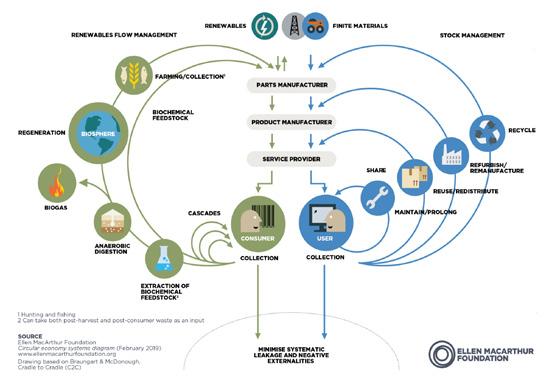
2 minute read
New economics
5
Climate careers
As outlined by the UK’s recent ten-point plan for a ‘green industrial revolution’, fighting climate change can be framed as an opportunity to create new jobs and pursue economic growth. Business concern for environmental issues has evolved out of more general calls for Corporate Social Responsibility (CSR), which has been defined as the economic, legal and ethical responsibilities of the private sector.53 From Victorian philanthropy to modern shareholder activism, CSR involves businesses minimising harm and actively working to solve social problems, within their workforce, in their surrounding communities and throughout their supply chains. In 1968, the Italian industrialist Aurelio Peccei and the Scottish scientist Alexander King convened a group of economists and scientists – in what became known as the Club of Rome – to explore the unsustainable direction of global capitalism. In their ground-breaking report The Limits to Growth, published in 1972, early computer models were used to explore the trends of accelerating industrialisation, rapid population growth, widespread malnutrition, depletion of non-renewable resources, and a deteriorating environment. On page 23 of their report, the authors stated:
If the present growth trends in world population, industrialization, pollution, food production, and resource depletion continue unchanged, the limits to growth on this planet will be reached sometime within the next one hundred years. The most probable result will be a rather sudden and uncontrollable decline in both population and industrial capacity.54
New economics
In the 1990s, many multinational corporations began to tackle ‘eco-efficiency’ as an opportunity to align business and social objectives. By reducing waste and avoiding pollution they
could also cut costs and reduce risks.55 This became known as the ‘triple bottom line’ of social, environmental and economic impacts. However, in recently revisiting the phrase he coined, the entrepreneur John Elkington argued that the triple bottom line was not intended merely as an accounting system, to boost profitability, but rather as a tool for disruption – ‘a genetic code, a triple helix of change for tomorrow’s capitalism’.56 Several new economic concepts are critical to understanding the opportunity of green growth and market-based solutions to the climate crisis. The economist Kate Rayworth has developed a theory of ‘doughnut economics’, to illustrate a world economy operating within both social and planetary limits.57 In this model, the doughnut is composed of two concentric circles: the outer circle captures the planetary boundaries beyond which we will overshoot ecological stability and resilience; while the inner circle reflects the basic needs of humanity, or sufficiency, as articulated by the SDGs (see page 14 above).
Figure 5 – 'Doughnut economics' model
(doughnuteconomics.org):58
Whilst setting a world record for the fastest solo circumnavigation of the globe, in 2004–2005, Dame Ellen MacArthur had an epiphany about finite resources, and on her return to the UK, became an advocate for the ‘circular economy’.59 Building on previous thinking about natural capital and industrial ecology, the circular economy elevates environmentalism’s ‘three Rs’ – reduce, reuse, recycle – to completely design out waste and pollution.60
Figure 6 – The Circular Economy (Ellen MacArthur
Foundation):61

Another criticism of the focus on economic growth and the failure of metrics like Gross Domestic Product (GDP) – which





